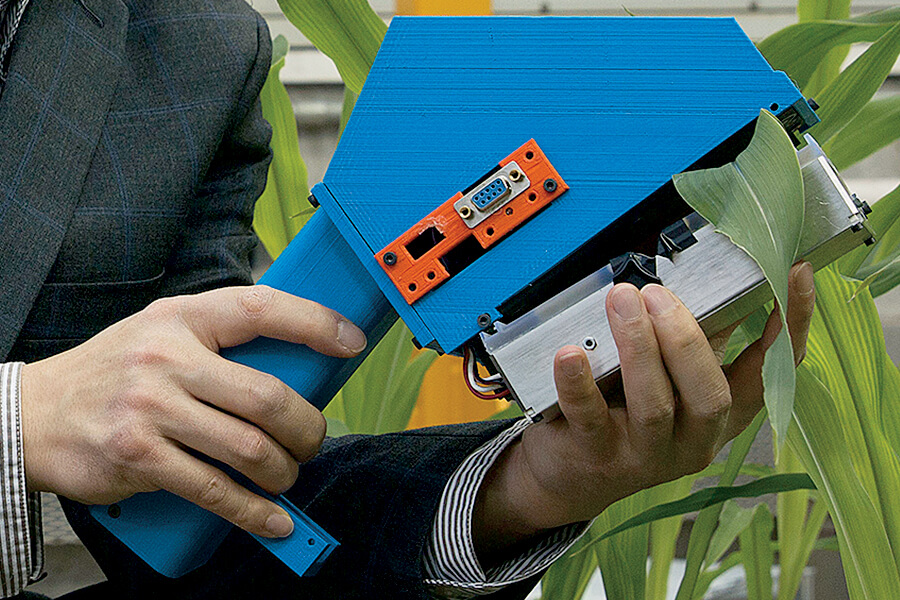Jian Jin, assistant professor of agricultural and biological engineering, has built an innovative handheld sensor that provides a more precise way of measuring the health of crops while gathering up-to-the-minute data that state and federal officials and others will find valuable.
He hopes his hyperspectral imaging device will be used widely by plant scientists and farmers nationally and internationally. The device scans a plant for physiological features, such as moisture, nutrient and chlorophyll levels, as well as different chemical spraying effects and disease symptoms, to determine whether it is healthy or under stress.
Jin says the hyperspectral imaging device he built will help farmers detect changes in plant health in the field hours to days before they are visible to the naked eye. It also will allow farmers to make necessary changes to grow more food using fewer resources, such as by reducing fertilizer and water use.
“My vision is this sensor will allow household farmers walking through a field to use a handheld device and a smartphone to get the same information available from very expensive phenotyping systems constructed by big companies and big universities in recent years,” Jin says. “We have 600 million farmers worldwide, and very few of them are benefiting from high-end plant sensor technologies. Now, with this handheld device, most farmers can benefit.”
The sensor, which can scan a plant in less than five seconds, can detect hundreds of bands of color in each pixel compared with the three bands of color detected by traditional cameras. One version also shoots a burst of fluorescent light off the plant. Both are used to measure stress and nutrition levels of the plant.
“We implemented both the hardware and software technologies into a handheld device that is light and easy to carry,” Jin says.
The sensor integrates the advanced image processing algorithm and plant features prediction models developed by Purdue scientists. These models were created with Purdue’s database containing years of plant research assays in both greenhouse and field. The models are also constantly improved and updated.

Improving Efficiency
There has been a rapid development of plant phenotyping in the past decade as technology is increasingly being used to improve efficiency based on current conditions instead of farmers relying on regional conditions and historical data to make decisions. Yet most farms manually check plant health with a method that lacks precision and efficiency.
Jin says his sensor is more precise than current devices used by plant scientists that clamp down on a leaf and measure the health of only a portion of the plant.
“Due to multiple technical reasons, the sensor’s prediction quality is much more accurate than any other types of crop imaging sensors that people have in the existing market,” Jin says. “It’s also constantly getting better because we scan plants every day and are upgrading both hardware and software technologies.”
Although the sensor is self-contained, the users also have the option to upload the measurements with geo-locations to a web-based cloud map service developed by Carol Song and her team at Purdue’s Advanced Computing Group. The system generates plant stress and nutrition heat maps based on the sensor measurements and provides interactive ag data querying functions at both farm and regional levels. This digital ag map system with sensor data can support many potential applications. For example, the data collected will provide valuable information to state and federal officials about steps they can take to help farmers during severe crop stress periods, as well as information about what types of crop yields can be expected.
“If we can successfully distribute the sensors around the region, we can generate this digital ag map service to monitor the plant growth all over the region — which areas are under stress and which areas are having a good performance,” Jin says.
His group at ABE is working on automation of this device. He and his graduate students worked with a senior design group from the School of Mechanical Engineering and successfully implemented a robot to scan the leaves with the sensor automatically in the greenhouse. The robot utilized machine vision to recognize the target leaves and carry the sensor over there for a quick scan operation along the leaf’s natural slope. Encouraged by the success in the greenhouse, Jin and his team are moving on for the design of the next robot in the farm field environment. The robot system may look like a spider transformer: It travels between crop rows, with each leg equipped with a sensor, waving and scanning leaves in the field with a very high speed. Jin expects the prototype to be functioning during the 2019 growing season.

Collaborators
Besides the engineers from ABE, the sensor’s development has been supported by breeders and biologists at Purdue, including professors Mitch Tuinstra, scientific director of the Purdue Institute for Plant Sciences and the Wickersham Chair of Excellence in Agricultural Research; and Tony Vyn, the Henry A. Wallace Chair in Crop Sciences. Carol Song and her team of data scientists from Advanced Computing Group provided the GIS map functions. Gerald Shively from Agricultural Economics has been promoting the application of the device as a social scientist.
The Purdue Office of Technology Commercialization has filed three applications for provisional patents for the technology.



